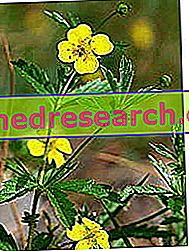Under the term Potentilla two plants particularly rich in tannins, respectively called:
tormentilla ( Pontetilla tormentilla Nec. = P. erecta L. Rau.)
and argentina ( Potentilla anserina L.).

Potentilla tormentilla
Botanical name: Pontetilla tormentilla Nec. = P. erecta L. Rau.
Family: Rosaceae
Drug: rhizome
Herbaceous plant widespread in the woody and fresh places of central and northern Europe. It has basal leaves divided into three to five lobes, with very intense yellow flowers, isolated and composed of four petals (contrary to the characteristic predominantly pentamous family). In Italy it can be found in the sub-mountain and in the alpine areas.
| ACTIVE PRINCIPLES | PROPERTY |
Catechic tannins (17-22%) Tormentol, pigment Starch Flavonoids saponosidi | Astringents, antidiarrheal Cicatrizzanti (external use) Hemostatic, anti-inflammatory Antibiotics towards some micro- organisms, antiviral |
MAIN INDICATIONS: tormentilla rhizomes are particularly rich in tannins; therefore, if taken orally, they are a valid natural remedy against diarrhea. In the form of rinses they are indicated in the symptomatic treatment of inflammation of the oral cavity (canker sores, mouth ulcers etc.).
FURTHER INDICATIONS: tormentilla is indicated not only in the symptomatic treatment of oral inflammation, but also in that of other accessible mucous membranes. The healing and antibacterial properties justify its topical use for cleansing sores and wounds, also benefiting from the stimulating action on skin repair processes.
The astringent properties of tormentilla can make it a useful hemostatic remedy to stop bleeding of different nature, such as epistaxis and bleeding of hemorrhoids. The anti-inflammatory and haemostatic action makes it particularly suitable in the local treatment of gingivitis and stomatitis, through gargling or brushing done with undiluted dye. The tormentilla, and even more so the Argentine, are indicated - in the form of irrigation - also in the treatment of leucorrhoea.
NOTES: the tannins cause vasoconstriction, obstructing the vasodilation and the consequent increase in vascular permeability that accompany the phlogistic phenomena. When applied topically to the skin or damaged mucosa, they bind tenaciously to epithelial cell proteins. Once in contact with the intestinal mucosa, therefore, the tannins reduce their permeability, producing an astringent effect particularly useful in the presence of diarrhea. At this and other levels, protein coagulation leads to the formation of a protective and antisecretive layer, useful for preventing the passage of pathogenic microorganisms and calming local inflammation.
METHOD OF USE AND DOSAGE:
Infusion (for internal use): single dose prepared with 1.4 - 4 grams of drug (dried and finely chopped tormentilla rhizome), in 300 ml of water, to be consumed several times a day up to a maximum daily dosage of 12 grams of drug. Take according to the herbalist's directions.
Decoction (for internal use): single dose prepared with 1.4 - 3 grams of drug (dried tormentilla rhizome) in 300 ml of water, to be consumed several times a day up to a maximum daily dosage of 6 grams of drug. Take according to the herbalist's directions.
Decoction (for rinses, gargles, wraps and external use): 50 grams of drug (dried tormentilla rhizome) per liter of water.
Powder / dry extract: take 4-6 grams of drug a day divided into three intakes, as recommended by the herbalist or the product label.
Potentilla or Tormentilla - Properties and uses in phytotherapy and homeopathy
Watch the video
X Watch the video on youtubeSIDE EFFECTS, CONTRAINDICATIONS, WARNINGS
Contact your doctor if diarrhea persists after three to four days of potentilla tormentilla treatment. Given the absence of reliable data on the toxicity profile in similar conditions, its use during pregnancy, lactation and under 14 years is not recommended.
The use of herbal preparations, including those based on tormentilla, can negatively interfere with the absorption of other drugs, increasing or decreasing their therapeutic effect. It is therefore advisable to take this remedy at least 2-3 hours after taking medicines.
In sensitive patients, treatment with potentilla tormentilla can cause episodes of nausea and vomiting.



